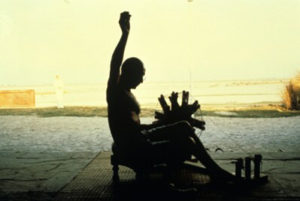For the past month, the streets of my town and most of the posts in my social media feed have been awash with resisting President Donald Trump. Resist this executive order! Oppose that cabinet nominee! Sign this petition, go to that rally!
My liberal friends think the world is coming to an end – just like my conservative friends did in 2009 when Barack Obama became president and started signing executive orders.
In my view, the world as we know it is coming to an end like a big old bus headed for a cliff. The two corporate political parties have been locked in mortal combat over which one gets to drive the bus over the final brink.
All the talk of resistance and protest has got me re-reading my Mahatma Gandhi. His success in resisting – and eventually driving out – the British Raj with nonviolence is iconic and unparalleled. Five years after Gandhi declared that the British should “Quit India,” they packed up and left.
What would Gandhi do – about Donald Trump? I’m seeing three important lessons.
1. We must not tolerate our oppressors. Gandhi was unswerving in his criticism of the British Raj. A foreign power had come to impose its will and civilization on India. This power sought the destruction of India as it had been evolving for centuries. The aim of this domination was to enhance the economic position of Britain.
“The British people appear to be obsessed by the demon of commercial selfishness. The fault is not of men, but of the system,” Gandhi told Louis Fischer in The Life of Mahatma Gandhi. “The true remedy lies in England’s discarding modern civilization, which is ensouled by this spirit of selfishness and materialism.”
He went on to say Britain’s “modern civilization” had destroyed India’s “village system” and given rise to sorrowful cities like Calcutta and Bombay.
“The railways, machineries and the corresponding increase of indulgent habits are the true badges of slavery of the Indian people, as they are of Europeans,” he said.
Like India of the 1930s and 1940s, we face an oppressive system rooted in selfishness and materialism – let’s call it the Corporate Raj. It doesn’t seem like a foreign power, because it looks and acts American. It speaks English, calls itself Democratic and Republican and Christian.
All the same, it is a system bent on consuming natural resources and energy, aimed at enhancing the economic position of the wealthy. It is crippling the planet’s ability to sustain life as we know it.
In many ways, the Corporate Raj is a more brutal regime than the British Raj could ever imagine. It’s a Death Star! The system is fundamentally flawed and cannot be fixed by holding more elections or working for incremental reforms. I believe Gandhi would warn us not to tolerate such a system, even if makes us comfortable for now.
2. It is more important to build a new system than to resist the current one. When faced with a huge power dedicated to destroying his country, Gandhi developed a vision of Swaraj – Independence.
He was convinced that Complete Independence could only be won through nonviolence. Using violence to overthrow the British would make Indians just as bad as their oppressor. Gandhi coined the term “satyagraha” to describe the “truth force” that would vanquish the enemy by turning him into a friend.
Satyagraha had two main components – Resistance and the Constructive Program. In essence, oppose what is bad and build what is good.
While Gandhi is most widely known for his use of Civil Disobedience to oppose British oppression, he gave top priority to the Constructive Program.
And make no mistake – holding up signs, attending rallies, calling elected officials and signing petitions are not acts of Civil Disobedience. They are all legally accepted activities of the status quo, better labeled “civil obedience.”
“The Constructive Program is the truthful and non-violent way of winning Poorna Swaraj,” Gandhi wrote in his 1941 pamphlet, Constructive Program: Its Meaning and Place. “Its wholesale fulfillment is Complete Independence, designed to build up the nation from the very bottom upward.”
Civil Disobedience –breaking unjust laws and accepting the legal consequences – is simply a tool to aid the Constructive Program, used only if the oppressive power tries to stop what you are building. Gandhi concluded: “Civil Disobedience without the Constructive Program will be like a paralyzed hand attempting to lift a spoon.”
I believe Gandhi would admonish us to be very busy building the kind of communities we want to live in regardless of who is driving the country towards the cliff. His vision of a “Free India” would be right at home in Chapter 14 of Bill Mollison’s Permaculture: A Designers’ Manual, “The Strategies of an Alternative Global Nation.”
3. Imagine and work for a new “Free America.” Permaculture shares a vision of self-reliant communities building local food, water and energy systems. These are tools to re-create the village system that has been destroyed by the Corporate Raj.
A Free America would reject the commercial selfishness of modern civilization and move ahead to the past.
“We have long been accustomed to think that power comes only through legislative assemblies. I have regarded this belief as a grave error brought about by inertia or hypnotism,” Gandhi wrote. “It is Swaraj when we learn to rule ourselves. The village would become a self-governing unit living its own life.”
Rather than centralizing power in a national government, Gandhi saw power spread to India’s 700,000 villages, with representatives moving up a very small ladder to a bare-bones federal assembly – not unlike the United States in its first decade, under the Articles of Confederation.
All village residents would participate in village governance and send one representative to a district assembly to deliberate on broader affairs. Districts would field one representative to a provincial assembly, which would then select a president to act as national chief executive.
Imagine all the time and energy spent wrangling in Washington, D.C. shifted to building local self-reliant communities! Imagine people meeting their basic needs at home rather than chasing after consumer goods from all over the planet!
I believe that if Gandhi lived today in Trump’s America, he would be walking the same road he did in 1941 – spinning his own thread, making his own salt, embracing his Muslim, Christian, Zoroastrian and Jewish neighbors – and saving his non-compliance for the time when the police or military tried to stop him.
I think that’s what he meant by “Be the Change.”



